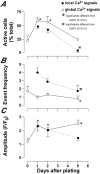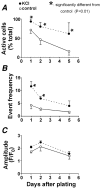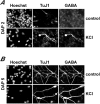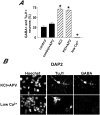Local and global spontaneous calcium events regulate neurite outgrowth and onset of GABAergic phenotype during neural precursor differentiation
- PMID: 12514206
- PMCID: PMC6742163
- DOI: 10.1523/JNEUROSCI.23-01-00103.2003
Local and global spontaneous calcium events regulate neurite outgrowth and onset of GABAergic phenotype during neural precursor differentiation
Abstract
Neural stem cells can generate in vitro progenitors of the three main cell lineages found in the CNS. The signaling pathways underlying the acquisition of differentiated phenotypes in these cells are poorly understood. Here we tested the hypothesis that Ca(2+) signaling controls differentiation of neural precursors. We found low-frequency global and local Ca(2+) transients occurring predominantly during early stages of differentiation. Spontaneous Ca(2+) signals in individual precursors were not synchronized with Ca(2+) transients in surrounding cells. Experimentally induced changes in the frequency of local Ca(2+) signals and global Ca(2+) rises correlated positively with neurite outgrowth and the onset of GABAergic neurotransmitter phenotype, respectively. NMDA receptor activity was critical for alterations in neuronal morphology but not for the timing of the acquisition of the neurotransmitter phenotype. Thus, spontaneous Ca(2+) signals are an intrinsic property of differentiating neurosphere-derived precursors. Their frequency may specify neuronal morphology and acquisition of neurotransmitter phenotype.
Figures









References
-
- Berridge MJ, Bootman MD, Lipp P. Calcium—a life and death signal. Nature. 1998;395:645–648. - PubMed
-
- Bootman MD, Lipp P, Berridge MJ. The organisation and functions of local Ca2+ signals. J Cell Sci. 2001;114:2213–2222. - PubMed
-
- Carey MB, Matsumoto SG. Spontaneous calcium transients are required for neuronal differentiation of murine neural crest. Dev Biol. 1999;215:289–313. - PubMed
-
- Cheng H, Lederer WJ, Cannell MB. Calcium sparks elementary events underlying excitation-contraction coupling in heart muscle. Science. 1993;262:740–744. - PubMed
Publication types
MeSH terms
Substances
LinkOut - more resources
Full Text Sources
Other Literature Sources
Medical
Miscellaneous
